ISSN ONLINE(2278-8875) PRINT (2320-3765)
ISSN ONLINE(2278-8875) PRINT (2320-3765)
| R.Brindha1 , V.Ganapathy1 ,S.Apnapriya1 ,J.Venkataraman1 SRM University, Chennai, India |
| Related article at Pubmed, Scholar Google |
Visit for more related articles at International Journal of Advanced Research in Electrical, Electronics and Instrumentation Engineering
This paper introduces third harmonics injection applied to three phase/three level/three switch unidirectional pwm rectifier. In general a Vienna rectifier converters is utilized to eliminate the low frequency harmonics in the line current while achieving unity power factor at the rectifier input terminals and load across dc output voltages.The modulation scheme incorporates third-harmonic frequency to modulate the current at dc-link. The modulated currents are then circulated through the ac-side of the Vienna rectifier, using a zigzag autotransformer. The above proposed technique is modeled in mat lab/Simulink platform
Keywords |
| Vienna rectifier, Third harmonics injection, Power factor correction. |
INTRODUCTION |
| Power Factor Correction (PFC) circuits are widely requires AC-to-DC energy conversion systems that use power electronic devices.. However, bridge rectification inherently draws non-sinusoidal current from the mains, which make it inadequate for high power applications due to the strict regulations on conducted EM (electromagnetic) energy, as well as the high current stress on components. For high power applications, the sinusoidal current must be actively shaped by using either a boost type front-end converter or by complex EM filtering at the input Conventional diode rectifiers and thyristor rectifiers draws a pulsed current from the ac main, producing significant current harmonics in the system. Controlled rectifiers are classified as being either isolated or non-isolated. For three-phase rectifiers, the non-isolated topologies are derived from the isolated topologies with the magnetic coupling (and thus isolation) achieved by the use of split inductors. However, under most circumstances the large, low frequency output voltage ripple is intolerable for direct use[1]. |
| A DC-DC converter is usually used as second stage to the AC-DC converter and isolation is achieved in the second stage. For this reason it is unnecessary to use an isolated AC-DC front-end converter[2]. Currently research is done on three topologies of three-phase active rectifiers. The first topology is a one quadrant, threephase, single-switch, two-level converter. This topology shapes the input current using a single switch and the output is a single positive voltage. The second topology is a four quadrants, three-phase, six-switch, two-level converter with, as the operation implies, bi-directional current flow capability. Six switches are used to shape the input current and the output is also a single positive rail. The third topology is a one quadrant, three-phase, threeswitch, three-level topology. Input current waveforms are controlled by three switches and the output is a positive split DC rail. The third topology mentioned is also known as the VIENNA rectifier and most of the current research focuses on this type of rectifier and variants. Several Harmonic reduction techniques are evaluated on the basis of their ability to operate with low THD in the input line current[3][4]. |
| It is shown that third harmonic current injection approach (fig 1) is the most suitable when a regulated dc output is required. This is because the third harmonic current circulation approach has very low switch ratings, and lower control complexity. In addition active power factor correction techniques are becoming increasingly more demanded feature in off-line industrial equipment [5].Boost converter topology was presented in earlier work [6] for power factor correction, and that topology can operate in continuous mode for high-power application and in discontinuous mode for lower power. This paper investigates by mean of simulation the performance of a third harmonic injection applied to Vienna rectifier and circulation technique, that will generate a regulated output voltage and low harmonic distortion in the line current. |
1. Operation of Vienna rectifier using third harmonic injection |
| The Vienna rectifier and the current circulation network are connected to the utility. Each diode in the diode bridge rectifier conducts for 120 degrees. The current circulation network consists of a zigzag connected transformer where each primary winding is split in two, connecting one phase of the utility to the output common node [7]. The control circuit forces the dc link side current to contain a dc component and varying higher order harmonics depending on the instantaneous input. Voltage and output voltage relationship. |
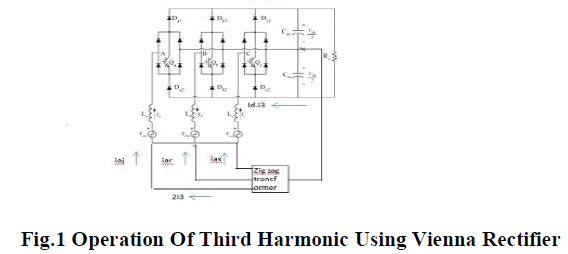 |
| The switches are controlled independently. In the first approach, the current coming out of the rectifier is forced to have two components: a dc component and a third order harmonic component in both modes of operation. The link inductor current in the Buck mode will then consist of a dc component and a multiple of third order harmonics. In the second approach, the link inductor current is forced to consist of a dc and a third harmonic component only. Therefore the current coming out of the rectifier will have a dc component and a multiple of third order harmonic components in the operation mode. |
2. Single phase Operation of the Vienna rectifier |
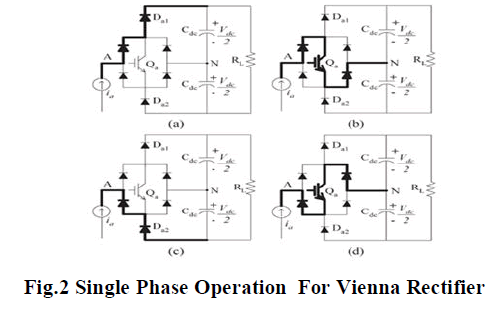 |
| The above circuit is single phase operation for Vienna rectifier if the line current ia is positive, and the controlled switch Qa is off, the voltage between the converter pole A and the dc-bus midpoint N (i.e., vAN) is Vdc/2. The conduction path for this case is illustrated in Fig.2 (a). If the line current ia is positive, and the controlled switch Qa is on, the voltage vAN is 0, in which case the conduction path is illustrated in Fig.2 (b). Similarly, if the line current ia is negative, the voltage vAN can be either –Vdc/2 if the switch Qa is off or zero if the switch Qa is on, as illustrated in Fig. 2(c) and 2(d), respectively. This operating principle also applies to phase legs B and C. |
3. Operation for Vienna rectifier using zigzag transformer |
| The scheme in which modulate the current in the dc-link to be ( I d + i3) and ( I d - i3)as shown in Fig. 1. ID is the dc component of the currentand2i3 is the third-harmonic modulation current flowing in the dc-link Inductors. The reduction of the line current harmonics by the circulation of third-harmonic currents is illustrated with the help of Fig.1. The currents from these two sources add up, at the midpoint n, and the sum 2i3 is circulated through the ac side of the rectifier by a zigzag autotransformer. The zigzag connection presents a high magnetizing impedance for the fundamental third-harmonic (zero-sequence) current . The total third harmonic current 2i3 splits equally in the three legs of the transformer and constitutes the current iaj flowing in each leg.. The line current iaj, seen to approach the sinusoidal wave shape and has reduced harmonic content. Similarly same for the operation phase leg B and C.If the distortion in the utility voltage results in a zero-sequence voltage component, it raises the potential of the midpoint n in Fig. 1 with respect to the utility neutral. However, no zero-sequence currents would flow due to this zero-sequence voltage in the utility, since the current in the neutral of the zigzag autotransformer is being forced to be 2i3. |
4. Block diagram of the controller |
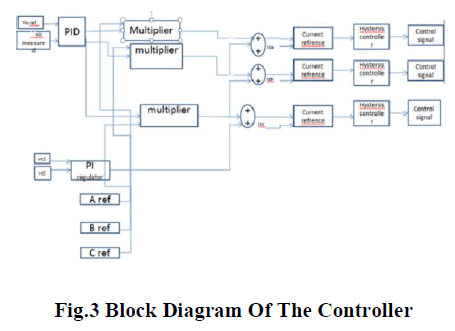 |
| The source side voltage taken and third harmonic scheme is applied then multiplied with connected value of midpoint dc link voltage maintained this value obtained is once again added up with the dc component of current and third harmonic modulation current flowing in the dc link then a hysteresis controller is applied producing pulses and then applied to the three switches of the Vienna rectifier. |
5. Concept and Calculation of Optimum Distortion |
| The amplitude and phase of 2i3are varied so as to minimize the combined rms value of thefirst49harmonic components in the line current. This analysis is based on the assumption that the zigzag autotransformer offers zero impedance to the zero-sequence third-harmonic currents and an infinite impedance to the nonzero-sequence fundamental frequency voltages .The sinusoidal PWM is the simplest modulation scheme to understand but it is unable to fully utilize the available DC bus supply voltage. Due to this problem, the third-harmonic injection pulse width modulation (THIPWM) technique was developed to improve the rectifier performance. Following Reference , consider a waveform consisting of a fundamental component |
| y = sinθ + A sin 3θ |
| where q =ïÿýïÿýt and A is a parameter to be optimized while keeping the maximum amplitude of y(t) under unity. The maximum value of y(t) is found by setting its derivative with respect to q equal to zero. Thus |
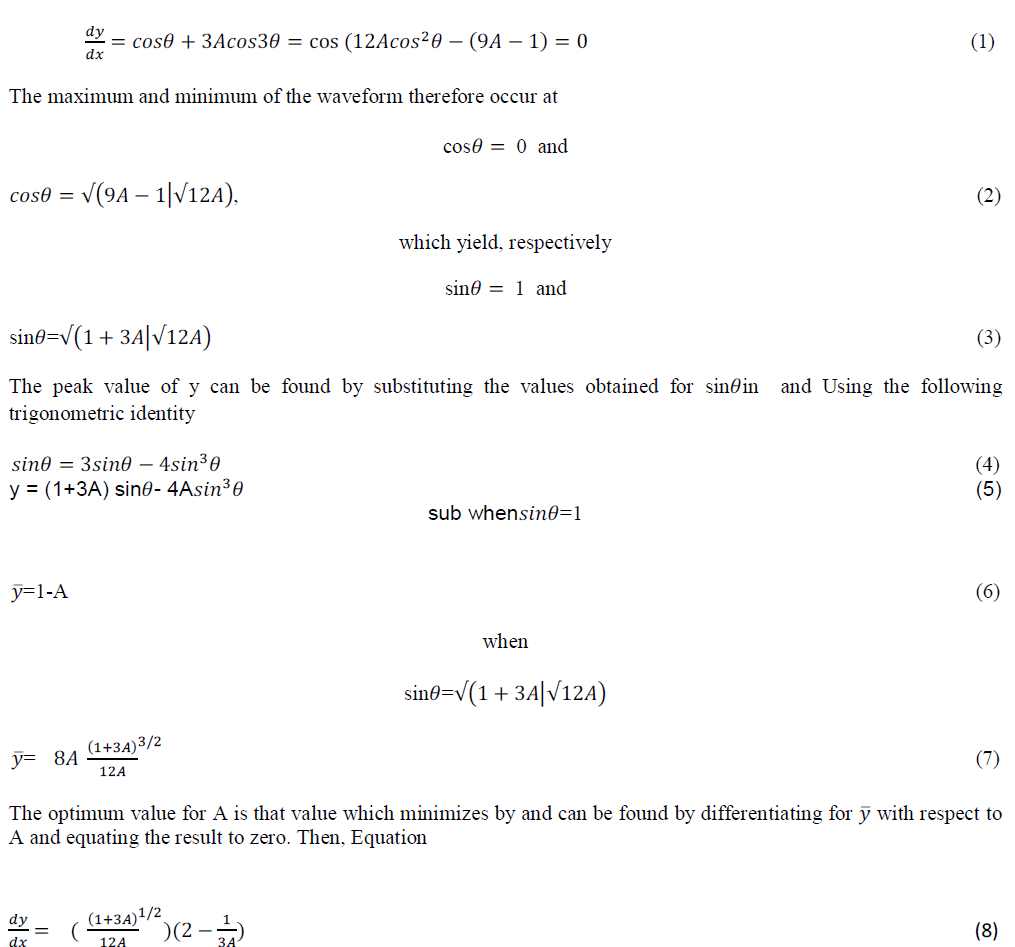 |
| Thus, the two possible values of A are |
| A = -1/3 and A=1/6 |
| we can see that the negative value of A makes by greater than unity. Therefore, the only valid solution for A is 1/6 and the required waveform is, |
| y = sinθ+1/6 sin 3θ |
| we see that the addition of this third harmonic produces a 15.5%increase in the amplitude of the fundamental of the phase voltages.. The peak√3/2 with one-sixth of the third harmonic added. The amplitude of the fundamental equals 1. The peak amplitude in equals 1 while the peak amplitude of the fundamental equals 2/√3 with one-sixth of third harmonic added. Injecting a third harmonic component to the fundamental component gives the following modulating waveforms for the three-phase. |
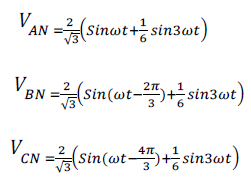 |
II. SIMULATION RESULT |
| The sinusoidal current rectifier using the three phase Vienna topology has been simulated using Mat lab platform The sinusoidal current rectifier is simulated from a balanced three phase, 60Hz, 462.5(line-to-line) supply with a source inductance (Ls) of 1mH. |
6. Vienna rectifier using zig zag transformer |
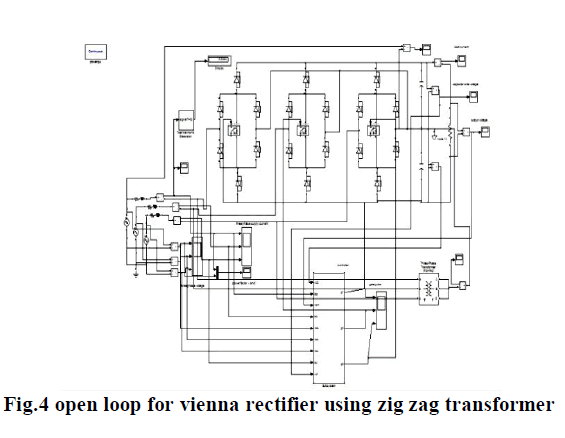 |
6.1 Controller |
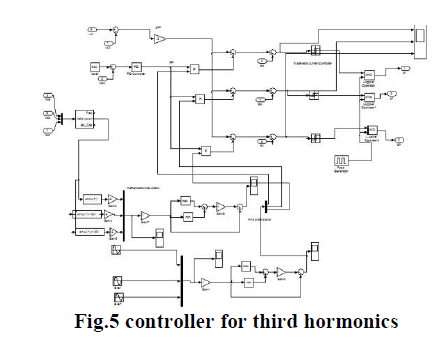 |
6.2 Power factor correction |
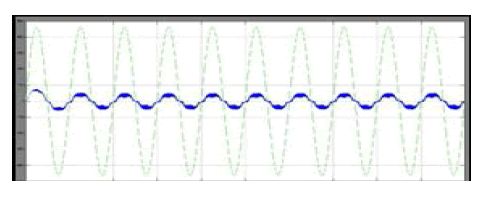 |
6.3 Three phase supply current |
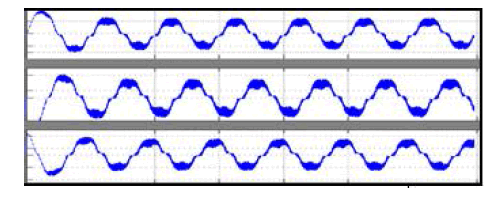 |
6.4 Third harmonics injection |
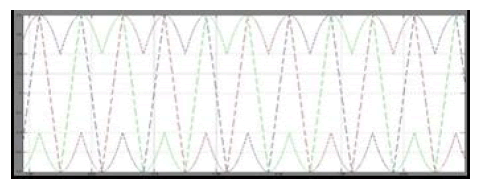 |
| It can be noted that the voltage between ïÿýïÿýïÿýïÿýïÿýïÿý and common is not sinusoidal in this case, but the actual phase voltage over the coil is sinusoidal with the peak amplitude of 463.5V, this leads to the line to line voltage to be near 300V, which realizes the full utilization of the DC link voltage. Compared to sine-wave PWM, this third harmonic injection method gives 15% more DC link voltage utilization. |
III. RESULTS AND DISCUSSION |
| The overall THD performance of Vienna rectifier in third harmonics is 1.06% THE following tabular column is due to phase in R,S,T in current in third harmonics Experimentally obtained distortions of the input currents are presented in Table I. The distortions of the input currents agree with theoretical predictions, and distortions of the input of about 3% negligibly affected the rectifier operation and distortion of the input currents. |
 |
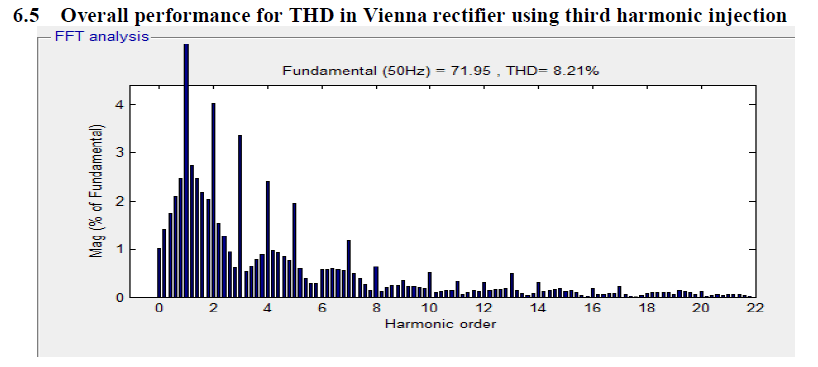 |
IV. CONCLUSION |
| The proposed three-phase three-switch three-level (VIENNA) rectifier circuit is implemented. Under the proposed control method and control circuit, the rectifier performs three phase ac to dc conversion generating sinusoidal input currents with reduced ripple and near unity power factor, while balancing the two dc output voltages. The third harmonics injection technique plays a significant role in reducing the THD of the utility line current of three phase controlled converters. The optimal amplitude and phase angle of the injection current changes with the firing angle. In this paper, a detailed analysis for determining the relation between the optimal amplitude and phase angle of the injection current along with the firing angle has been carried out The interface draws input currents with a harmonic distortion of less than 5% and provides a regulated dc voltage at the output. |
References |
|